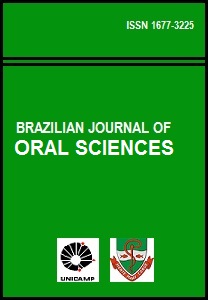Abstract
A supernumerary tooth is one that is additional to the normal series and can be found in almost any region of the dental arch. They have been described in both primary and permanent dentition. Multiple supernumerary teeth are rare in non-syndromic patients. The purpose of this study was to evaluate non-syndromic patients with five or more supernumerary teeth, by general and local clinical examinations, periapical, occlusal and panoramic radiographs. The patients’ data were collected regarding to the number of supernumerary teeth, location, shape, position and association to pathological lesion. Thirty-five supernumerary teeth were found, 17 in the mandible and 18 in the maxilla. In the lower arch, 16 supernumerary teeth were localized in the premolar region and 1 in a distomolar region. However, in the upper arch, there were 7 in the premaxilla, 6 in the premolar and 5 in the distomolar region. From the total, 28 were supplemental and 7 were found in a rudimentary shape. Completing the observations, 29 included teeth were detected and one showed a radiolucent area that suggested a dentigerous cyst. Six other teeth showed a widened follicular space. One of the upper molar from the normal series was related to an odontoma. We could conclude that mandible and maxilla were equally affected and most of the teeth morphology was similar in size and shape to normal tooth (supplemental). Twenty-nine teeth were impacted; however few have caused pathologies.References
Regattieri LR, Parker JL. Supernumerary teeth associated with Fabry-Anderson’s syndrome. Oral Surg Oral Med Oral Pathol. 1973; 35: 432-3.
Young WG, Sauk JR JJ, Pihlstrom B, Fish AJ. Histopathology and electron and immunofluorescence microscopy of gingivitis granulomatosa associated with glossitis and cheilitis in a case of Anderson-Fabry disease. Oral Surg Oral Med Oral Pathol. 1978; 46: 540-4.
Acton CH. Multiple supernumerary teeth and possible implications. Aust Dent J. 1987; 32: 48-9.
Hibbert S. A previously unreported association between NanceHoran syndrome and spontaneous dental abscesses. Oral Surg Oral Med Oral Pathol Oral Radiol Endod. 2005; 99: 207-11.
Scheiner MA, Sampson WJ. Supernumerary teeth: a review of the literature and four case reports. Aust Dent J. 1997; 42: 160- 5.
Batra P, Duggal R, Parkash H. Non-syndromic multiple supernumerary teeth transmitted as an autosomal dominant trait. J Oral Pathol Med. 2005; 34: 621-5.
Yusof WZ. Non-syndromal multiple supernumerary teeth: literature review. Gen Dent. 1990; 56: 147-9.
Duffy MT. Multiple impacted supernumerary teeth. Oral Surg Oral Med Oral Pathol. 1973; 35: 433-4.
Desai RS, Shah NP. Multiple supernumerary teeth in two brothers: a case report. J Oral Pathol Med. 1998; 27: 411-3.
Rajab LD, Hamdan MAM. Supernumerary teeth: review of the literature and a survey of 152 cases. Inter J Paediatric Dent. 2002; 12: 244-54.
Kokten G, Balcioglu H, Buyukertan M. Supernumerary fourth and fifth molars: a report of two cases. J Contemp Dent Pract. 2003; 4: 67-76.
Camilleri S. A case of bilateral supplemental maxillary central incisors. Int J Paediatric Dent. 2003; 13: 57-61.
Gunduz K, Sumer M, Sumer AP, Gunhan O. Concrescence of a mandibular third molar and a supernumerary fourth molar: report of a rare case. Br Dent J. 2006; 200: 141-2.
Primosch RE. Anterior supernumerary teeth. Assessment and surgical intervention in children. Pediatr Dent. 1981; 3: 204- 15.
Açikgöz A, Açikgöz G, Tunga U, Otan F. Characteristics and prevalence of non-syndrome multiple supernumerary teeth: a retrospective study. Dentomaxillofac Radiol. 2006; 35: 185- 90.
Bayrak S, Dalci K, Sari S. Case report: evaluation of supernumerary teeth with computerized tomography. Oral Surg Oral Med Oral Pathol Oral Radiol Endod. 2005; 100: 65-9.
The Brazilian Journal of Oral Sciences uses the Creative Commons license (CC), thus preserving the integrity of the articles in an open access environment.

